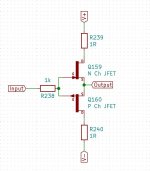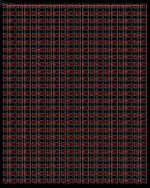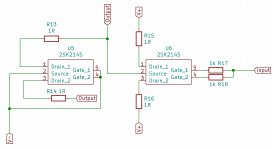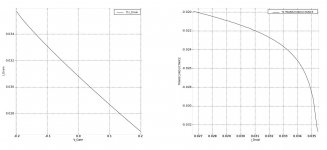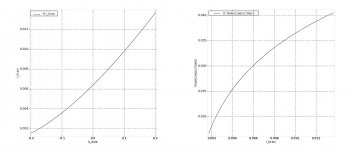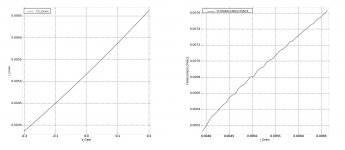The J113 was not intended to be the best choice for a micro-beast. Nelson has thousands of J113s, and they are cheap. With careful matching of the jfets the micro-beast has a DC offset of 2 mV. Nelson doesn't do surface mount parts.
The Toshiba 2SK2145 is an attractive part. Zen Mod uses them in the buffer section of his Iron Pumpkin, a brilliant sounding design. If I understand correctly, the Iron Pumpkin preamp uses two strategies to handle the DC offset problem. First, matching the 2sk2145s. Matching requires a special jig to measure the jfet. Second, adjusting the supply voltages to achieve low DC offset. Zen Mod suggested that his buffer design would make a good front for a micro-beast. Also Iron Pumpkin buffer's low output impedance will help drive the collective gate capacitance of paralleled jfets.
For a Beast, matching pairs is not important in my opinion. The way I am designing the boards, you can measure Idss of each individual transistor and disable one or more to adjust output offset by removing the drain resistor. Something that a DIYer can do.
I would use LSK170/J74 for input buffering to drive the beast if your preamp cannot tolerate the capacitance.
The plan for assembly is to install all of the 2SK340E parts and then install enough of the J270 parts to make the output offset as close to zero as possible.
I look forward to reading about the results of your beast design using complementary jfet pairs. Nelson's original beast employs both complementary jfet pairs and balanced inputs for very low harmonic distortion. It is my favorite sounding amp by far.
My next micro-beast amp will 2 use single-ended boards (each board 48 jfet followers with CCSs as before) per channel for balanced inputs. So we are each approaching Nelson's original beast from different sides.
Balanced inputs allow for balanced output (reduced 2nd harmonic), normal or inverted phase single-ended outputs.
If this approach works out, I was thinking of using the Toshiba 2SK209, the single jfet version of the 2sk2145. The 2SK209 has less 3rd order harmonic distortion than the 2SK170, is cheap, and in a balanced configuration should reduce the 2SK209's higher 2nd order harmonic distortion. Time will tell.
My next micro-beast amp will 2 use single-ended boards (each board 48 jfet followers with CCSs as before) per channel for balanced inputs. So we are each approaching Nelson's original beast from different sides.
Balanced inputs allow for balanced output (reduced 2nd harmonic), normal or inverted phase single-ended outputs.
If this approach works out, I was thinking of using the Toshiba 2SK209, the single jfet version of the 2sk2145. The 2SK209 has less 3rd order harmonic distortion than the 2SK170, is cheap, and in a balanced configuration should reduce the 2SK209's higher 2nd order harmonic distortion. Time will tell.
I look forward to reading about the results of your beast design using complementary jfet pairs. Nelson's original beast employs both complementary jfet pairs and balanced inputs for very low harmonic distortion. It is my favorite sounding amp by far.
My next micro-beast amp will 2 use single-ended boards (each board 48 jfet followers with CCSs as before) per channel for balanced inputs. So we are each approaching Nelson's original beast from different sides.
Balanced inputs allow for balanced output (reduced 2nd harmonic), normal or inverted phase single-ended outputs.
If this approach works out, I was thinking of using the Toshiba 2SK209, the single jfet version of the 2sk2145. The 2SK209 has less 3rd order harmonic distortion than the 2SK170, is cheap, and in a balanced configuration should reduce the 2SK209's higher 2nd order harmonic distortion. Time will tell.
Very nice of you to share your journey. It is a beautiful piece.
I have bought some 208s and 209s to evaluate. I also have a SOT23 socket so I can do some curve tracing. Picking up the part and placing it in the socket is a challenge.
The 2SK208, 209 and 2145 have power limitations. That is why I am thinking of using the GR grade parts. Just use many more of them. They are small and can be packed tightly. If the GR parts are used, Vds can be set to the datasheet maximum / 2.
As noted, Nelson is exploring different “beast” topologies. The picture below is one of his micro-beast topologies: 48 parallel cells, each cell consisting of a J113 jfet follower with a J113 jfet CCS. The poor design is purely my fault.
The micro-beast makes a wonder headphone amplifier. The 32 ohm output impedance drives my Final Audio D8000 headphones and even my Abyss 1266 TC. The micro-beast sounds as good in one minute as is one hour.
As expected, the single-ended topology yields a 2nd harmonic output. I’m running it with +- 12 vdc. Since it is a follower, voltage is not critical as long there is a volts of headroom. Each side draws 1.6 amps.i
Are all the Resistors the same? And will you show a schematic for the cells.
Are all the Resistors the same? And will you show a schematic for the cells.
Complementary buffer cell schematic attached.
Attachments
B1 power amp version
Here is the layout of a B1 power amp version using the 2SK2145. This is just the inner part. Terminal blocks and capacitors not added yet. Board will be 6 layers.
500 pcs of 2SK2145. 1000 JFETs total.
Dimension ~ 160mm x 210mm. After adding terminal blocks and capacitors, dimensions should be 210mm x 210mm.
Maximum power dissipation is 300mW for the entire package of the 2SK2145.
I think that the decision is what grade of 2SK2145 to populate. The Y grade or the GR grade. What voltage for the rails. 12V?
If the Y grade parts are used, voltage rails could be + / - 24v
Discussion welcome.
Here is the layout of a B1 power amp version using the 2SK2145. This is just the inner part. Terminal blocks and capacitors not added yet. Board will be 6 layers.
500 pcs of 2SK2145. 1000 JFETs total.
Dimension ~ 160mm x 210mm. After adding terminal blocks and capacitors, dimensions should be 210mm x 210mm.
Maximum power dissipation is 300mW for the entire package of the 2SK2145.
I think that the decision is what grade of 2SK2145 to populate. The Y grade or the GR grade. What voltage for the rails. 12V?
If the Y grade parts are used, voltage rails could be + / - 24v
Discussion welcome.
Attachments
I would use Y grade, without any source resistors; Idss spread ignored, as good enough (1.2 to 3mA), so with 500 cells you can expect at least 1A of Iq
output DC offset taken care of with preceding buffer stage
rails voltage - depending of intended use
though ...... maybe it is better to build proper big amp ...... it makes sense up to 100 cells ( purpose cans), everything above that could be just show off, which is already made
I mean - I'm not expecting better sonic results than with, say , M2 or many other candidate OS-es, when going in OS made for speakers territory
output DC offset taken care of with preceding buffer stage
rails voltage - depending of intended use
though ...... maybe it is better to build proper big amp ...... it makes sense up to 100 cells ( purpose cans), everything above that could be just show off, which is already made
I mean - I'm not expecting better sonic results than with, say , M2 or many other candidate OS-es, when going in OS made for speakers territory
Last edited:
I would use Y grade, without any source resistors; Idss spread ignored, as good enough (1.2 to 3mA), so with 500 cells you can expect at least 1A of Iq
output DC offset taken care of with preceding buffer stage
rails voltage - depending of intended use
though ...... maybe it is better to build proper big amp ...... it makes sense up to 100 cells ( purpose cans), everything above that could be just show off, which is already made
I mean - I'm not expecting better sonic results than with, say , M2 or many other candidate OS-es, when going in OS made for speakers territory
Thanks for the advice. My initial thought is also Y grade.
Making this into a power amp is interesting to some people. Some benefits compared to a proper typical output stagepower amp.
JFET is lower distortion than MOSFET
No heatsink required
No feedback
Self-biased. Any adjustment is just removing one or more resistors.
In Nelson's original Beast article, he was surprised by the sweetness of the sound of his JFET Beast.
In 2012 member bcarso measured that 2SK2145 has interchangeable drain and source, his conclusion at Discrete Opamp Open Design post #530.Discussion welcome.
Seems it is possible to create a B1 cell operating at Idss with a single 2SK2145 or 2SK3320 (same die smaller package).
Last edited:
In 2012 member bcarso measured that 2SK2145 has interchangeable drain and source, his conclusion at Discrete Opamp Open Design post #530.
Seems it is possible to create a B1 cell operating at Idss with a single 2SK2145 or 2SK3320 (same die smaller package).
That is a slick trick. Thank you for sharing. I believe that prevents me from disabling the lower half of the buffer for purposes of adjusting output voltage offset.
Last edited:
Are you sure? 🙂
A drain resistor on the bottom current source is not possible since the bottom drain is the top source.
I can add a source resistor on the current source which brings the resistor count to the same as what I already have laid out.
It may be possible to pack the buffers tighter with your suggestion.
I wouldn't dare to flip JFet, to mimic polarity counterpart
probably just from me being clueless, but better safe than sorry
- if that was meaning of explained
probably just from me being clueless, but better safe than sorry
- if that was meaning of explained
I wouldn't dare to flip JFet, to mimic polarity counterpart
probably just from me being clueless, but better safe than sorry
- if that was meaning of explained
I am not sure if I understand your "mimic polarity counterpart". Flipping the part only interchanges drain and source. It does not interchange N-JFET for P-JFET.
For the 2SK2145, if drain and source are interchangeable the way 2SK170 is interchangeable with drain and source, you can make a B1 buffer with one 2SK2145. It is a very clever trick.
> For the 2SK2145, if drain and source are interchangeable the way 2SK170 is interchangeable with drain and source,
> you can make a B1 buffer with one 2SK2145. It is a very clever trick.
Done that for umteen years.
SD Card Memory FLAC/WAV 192/24 player - ESS crescendo II - AK4495 - DV20A
B1-Turbo on a Chip
One Last Attempt at Discrete Opamp in DIP8 Footprint
You just need to measure Idss on both NJFETs beforehand.
Patrick
> you can make a B1 buffer with one 2SK2145. It is a very clever trick.
Done that for umteen years.
SD Card Memory FLAC/WAV 192/24 player - ESS crescendo II - AK4495 - DV20A
B1-Turbo on a Chip
One Last Attempt at Discrete Opamp in DIP8 Footprint
You just need to measure Idss on both NJFETs beforehand.
Patrick
Last edited:
A jumper can also be used there to allow operation at Idss and disconnect option of the lower half.I can add a source resistor on the current source which brings the resistor count to the same as what I already have laid out.
The idea is to make a B1 R1, not R2. 🙂I wouldn't dare to flip JFet, to mimic polarity counterpart...
Last edited:
- Home
- Amplifiers
- Pass Labs
- Beast with 1000 JFETs redux?
